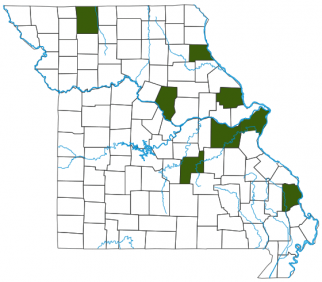
Common buckthorn is a many-branched, shrubby tree with a spreading, irregular crown.
Leaves are simple, some appearing alternate but most are opposite, egg-shaped, abruptly pointed (sometimes rounded) at the tip, finely toothed. Both upper and lower surfaces are smooth. Leaves have 3–5 pairs of veins branching from the midvein that curve along the edges of the leaf. Leaves appear early in spring and are retained late into autumn.
Bark is grayish brown with white narrow lines (lenticels), and is rough in texture at maturity. Trunk diameter to 10 inches.
Twigs are elongated, dark buds are closely pressed against the twig. The terminal bud is often modified into a spine.
Flowers April–June; male and female flowers usually produced on separate plants. Flowers have 4 small, yellowish-green petals and appear in clusters.
Fruits August–September, often remaining until December; round, black, small (up to ¼ inch in diameter), juicy, typically contain 3–4 seeds.
Similar species: Five species in genus Rhamnus are recorded to live wild in Missouri. See the Carolina buckthorn page for a discussion of them as well as a few other similar species.
Height: to 25 feet.

Current distribution is scattered in at least 9 counties, but it could become established throughout the state.
Habitat and Conservation
Common buckthorn is an invasive ornamental that escapes cultivation. It has become naturalized in woodlands, savannas, prairies, abandoned fields, pastures, fence rows, roadsides, and ravine slopes. It is cultivated for hedges and wildlife habitat and is used in shelterbelt plantings. The fruit is readily eaten by birds, which spread the seeds throughout the landscape. The shrub readily resprouts from cut or damaged stems. Making matters worse, this and other nonnative, Asian buckthorn species are the overwintering hosts for the soybean aphid, Aphis glycines, a serious pest of soybean crops that requires both buckthorn and soybean plants to complete its life cycle.
Status
A nonnative species native to Eurasia and introduced to North America as an ornamental shrub. It has become naturalized from Nova Scotia to Saskatchewan, south to Missouri, and east to Virginia. While listed as a noxious weed and prohibited in six states, there were no restrictions on common buckthorn in Missouri as of June 2011. Its use, however, is strongly discouraged, as it has already begun to establish itself in our state.
Life Cycle
Common buckthorn produces fruit that is readily eaten by birds. The severe laxative effect of the fruits readily distributes seeds. The shrub readily resprouts from cut or damaged stems.
Control
Human Connections
Although it is an invasive shrub, difficult to eradicate and a nuisance at best, these nonnative buckthorns are still sold as ornamentals and hedges by several nurseries. This plant is poisonous if eaten. Plant native shrubs instead — such as fragrant sumac, winterberry holly, or spicebush.
Common buckthorn and other buckthorns are alternate hosts for crown rust (or leaf rust) of oats (Puccinia coronata var. avenae). On oats, this fungal disease causes brown spots on leaves and shriveled grain, reducing yield and value.
Ecosystem Connections
Birds eat the berries, spreading this invasive shrub. Once established, common buckthorn shades and crowds out native shrubs and trees in the middle layer of woodlands, where many bird species nest. It forms an impenetrable layer of vegetation, degrading wildlife habitat.
In New England, invasively spreading common buckthorn may be causing the Henry's elfin butterfly to be increasing and expanding its range, as the butterfly now uses common buckthorn as a caterpillar host plant.





























